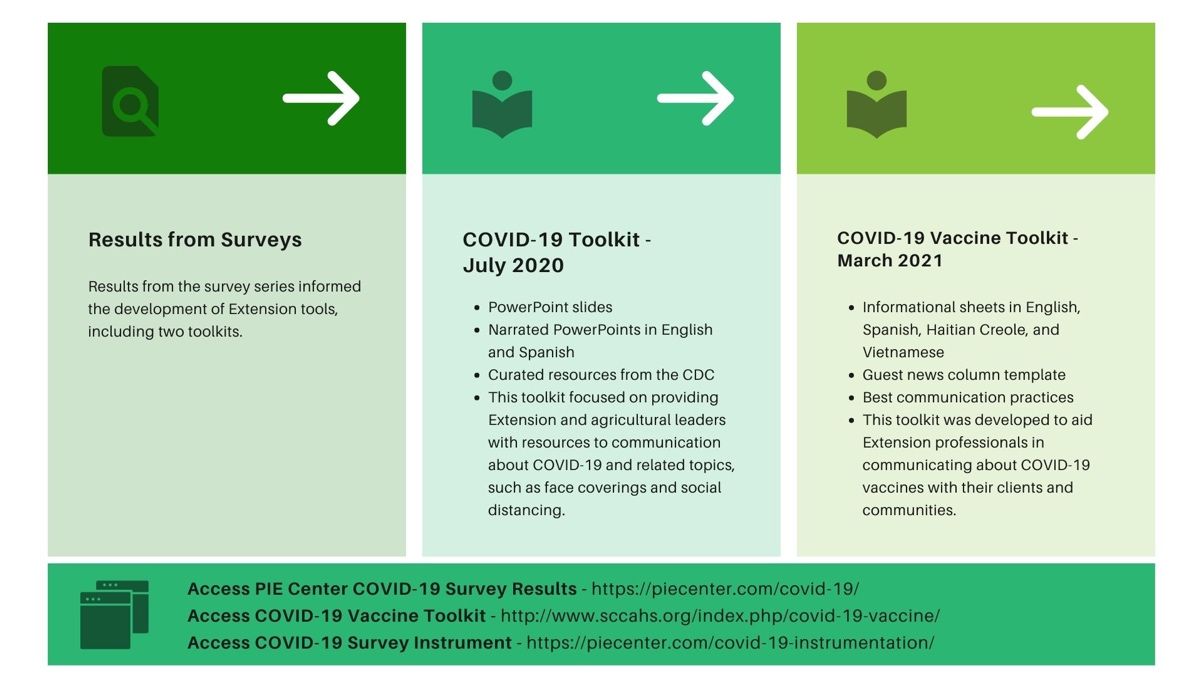Background
The UF/IFAS Center for Public Issues Education in Agriculture and Natural Resources (PIE Center) conducted a series of national public opinion surveys to examine Americans' perceptions related to COVID-19. The PIE Center launched the series of surveys in mid-March 2020 and continued collecting public opinion surveys related to COVID-19 through early 2022. In addition, the PIE Center surveyed leaders in agriculture and natural resources sectors to explore their unique concerns and beliefs early in the pandemic. Perception data collected through public opinion surveys informed the development of education and communication tools, such as fact sheets and social media graphics. This article focuses on the resources the PIE Center developed based on these data and the research tool used to collect data to inform the resource development. Other Extension professionals and faculty can use and adapt the survey tools to evaluate specific needs related to health in their states to create resources to meet their Extension stakeholders’ needs.
Extension Resources
The PIE Center used the survey tools described here to create Extension and outreach communication pieces, including issue guides, kinetic typography videos, webinars, and communication toolkits. For each survey, major findings were summarized in an issue guide, or an information sheet that provided a synopsis of a particular issue related to COVID-19, such as social distancing, mask wearing, or vaccines. These issue guides contained easy-to-understand graphs and data representations. Graphics used in the issue guides were also used as social media content and in kinetic typography videos. Kinetic typography videos are short, text-based videos with little to no narration. Additionally, these graphics were used for visual content in webinars. The PIE Center hosted a series of five webinars on topics related to COVID-19, including social distancing, communication concerns, and the COVID-19 vaccines. These webinars were targeted to Extension professionals, communicators, and public health professionals to provide valuable guidance on the public’s perceptions of COVID-19. Data collected from the PIE Center on Americans’ perceptions related to COVID-19 also informed two communication toolkits developed for Extension. Figure 1 outlines the details of the toolkits.

Survey Development and Use
Survey constructs were developed for the initial survey in March 2020. Some constructs remained the same across additional survey distributions, while others evolved as the science and recommendations related to COVID-19 evolved. Surveys were conducted with the American public with ~1,500 US adults using nonprobability (nonrandom) quota sampling based on the US Census. The surveys with the American public were conducted at four different times with public opinion 1 (PO 1) ran from March 13 to 16, 2020; public opinion 2 (PO 2) ran from April 23 to May 2, 2020; public opinion 3 (PO 3) ran from July 23 to August 9, 2020; and public opinion 4 (PO 4) ran from January 8 to January 21, 2021. The agriculture and natural resource leaders survey (ANR) ran from March 16 to April 21, 2020, and included 225 ANR leaders from 17 different states who participated in 8 different state agricultural leadership programs. Constructs included in these surveys and the reliability of those constructs from each survey are included in Tables 1–4. While the PIE surveys contained a wide array of items, the focus of this article is on the concerns related to COVID-19. You can view more details about the surveys, including survey results, and download questions at https://piecenter.com/covid-19-instrumentation/.
All concern items began with a yes/no question to determine if they were concerned about the item. If they answered “yes” they were concerned, then they were asked how concerned they were on a scale of 1–5, with 1 = only slightly concerned to 5 = extremely concerned. The yes/no initial questions are included in the following tables.
Table 1. General Concern Items.
Table 2. Economic Concern Items.
Table 3. Preparedness Concern Items.
Table 4. Communication Concern Items.
Demographic Items Unique to COVID-19
Demographic items were included in all surveys related to age, income, race, ethnicity, political beliefs, residency location, occupation, and gender. Some demographic items were developed specific to COVID-19, and these items are included in Table 5 so others can consider the use of these items to meet the needs of resource development in their Extension programs.
Table 5. Demographic Survey Items Specific to COVID-19.
Conclusion
COVID-19 has impacted all Extension systems, and the needs of stakeholders related to this topic may have shifted during this time. Others interested in developing resources based on the needs and perceptions of their stakeholders related to COVID-19 or future health crises are encouraged to conduct similar research within their Extension systems. As future public health outbreaks occur, practitioners can collect information, by applying the survey shared in this document, to determine what information needs stakeholders have and then develop resources to best address those needs. For example, if stakeholders indicate they are most concerned about personally contracting COVID-19, or other diseases, resources should be developed that specifically focus on protective actions individuals can control for themselves. If people are interested in using the PIE Center materials created from this work, they can download these at https://piecenter.com/covid-19.